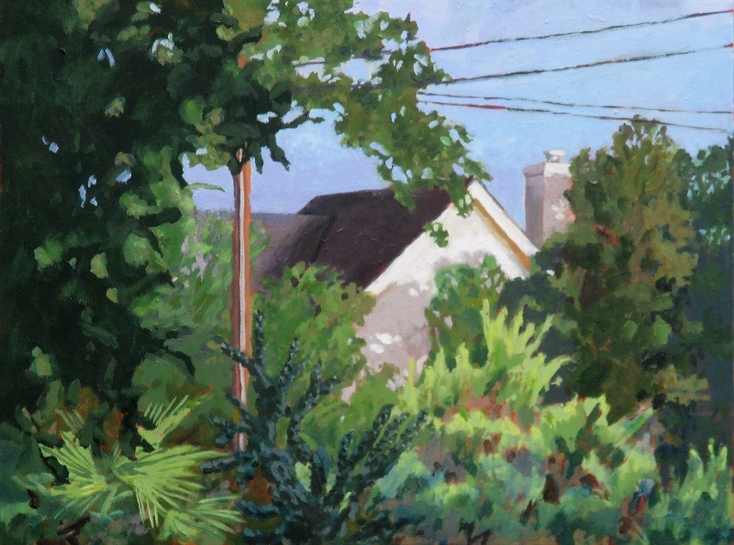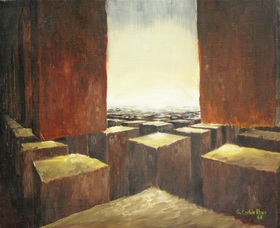My more recent work has been worrying me a little bit. Even at my advanced age I am learning by leaps and bounds. I am discovering and implementing advances in my conception and execution with every new serious work. But most of the breakthroughs are subtle even if profound. I am very happy with my progress but am I cutting edge enough? Am I producing works of significance? Sometimes I think, sure, this is working pretty well, but isn’t it just another magazine illustration—or less?
Those close to me do see my evolution, and are excited for me, but I find myself pondering my beautiful-woman-in-the-movies question:
We see a stunning woman in films, acting as an average person, and there is no question about her. If you see her on the street you see a knockout. She is gorgeous on screen and she is gorgeous on the street. Somehow we tolerate the idea that someone so beautiful could lead so prosaic a life as she plays in the movies. But what about the average-looking woman on screen? She plays the not-so-attractive second fiddle to the stunner but how does she come across on the street, walking among the rest of us poor fours and fives? I suspect that in daily life many such a “mere” seven is recognized as a beauty.
I cannot forget that however much my work pleases me and those around me, it is very much just another also-ran in the wider world.
James Lord, in his book A Giacometti Portrait, quotes Giacometti as envying the everyday illustrators who could make straightforward renditions of people. Lord was surprised; I wasn’t. I too worry about all the things I am not.
According to tests, I am pretty smart, but I am no Giacometti, no Picasso, no Modigliani. I could emulate those guys, but I could never have been them. The same is true in mathematics and any other talent that I enjoy. Even if I were one in ten thousand, I would still share the stage with 700,000 others (because there are 7 billion people on Earth), and I am thoroughly comfortable with working at my own ascending level of proficiency. Some of us resort to planned obsolescence but I don’t want to do that—not because I expect these paintings to be around in 500 years, but because I don’t like the look on my own easel.
That’s not to say I don’t bring everything I know to bear on every painting. There is so much to learn in the pursuit of this calling; and whether it is from books, or looking at the art of others—from the cave paintings to museums to the web—or from practice, a committed artist will never stop striving for the mastery that eludes us.
I just want to do genuine work, real work, authentic work. I want my goals to be purely artistic, and not polluted with the attempt to be anybody else’s idea of fashionable. I resent any pressure—and it is everywhere—to be unique, to be shocking, to be sensational. Each of us is already quite unique, and the world is sometimes shocked at those of us who let it show. It’s not easy to be authentic; it’s sensational when we succeed. I am working very very hard at sticking to my own inspiration.
Coming up: What do I want from this? and What makes the great so great?
Those close to me do see my evolution, and are excited for me, but I find myself pondering my beautiful-woman-in-the-movies question:
We see a stunning woman in films, acting as an average person, and there is no question about her. If you see her on the street you see a knockout. She is gorgeous on screen and she is gorgeous on the street. Somehow we tolerate the idea that someone so beautiful could lead so prosaic a life as she plays in the movies. But what about the average-looking woman on screen? She plays the not-so-attractive second fiddle to the stunner but how does she come across on the street, walking among the rest of us poor fours and fives? I suspect that in daily life many such a “mere” seven is recognized as a beauty.
I cannot forget that however much my work pleases me and those around me, it is very much just another also-ran in the wider world.
James Lord, in his book A Giacometti Portrait, quotes Giacometti as envying the everyday illustrators who could make straightforward renditions of people. Lord was surprised; I wasn’t. I too worry about all the things I am not.
According to tests, I am pretty smart, but I am no Giacometti, no Picasso, no Modigliani. I could emulate those guys, but I could never have been them. The same is true in mathematics and any other talent that I enjoy. Even if I were one in ten thousand, I would still share the stage with 700,000 others (because there are 7 billion people on Earth), and I am thoroughly comfortable with working at my own ascending level of proficiency. Some of us resort to planned obsolescence but I don’t want to do that—not because I expect these paintings to be around in 500 years, but because I don’t like the look on my own easel.
That’s not to say I don’t bring everything I know to bear on every painting. There is so much to learn in the pursuit of this calling; and whether it is from books, or looking at the art of others—from the cave paintings to museums to the web—or from practice, a committed artist will never stop striving for the mastery that eludes us.
I just want to do genuine work, real work, authentic work. I want my goals to be purely artistic, and not polluted with the attempt to be anybody else’s idea of fashionable. I resent any pressure—and it is everywhere—to be unique, to be shocking, to be sensational. Each of us is already quite unique, and the world is sometimes shocked at those of us who let it show. It’s not easy to be authentic; it’s sensational when we succeed. I am working very very hard at sticking to my own inspiration.
Coming up: What do I want from this? and What makes the great so great?



 RSS Feed
RSS Feed